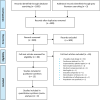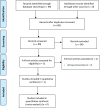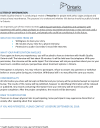Vaginal Pessaries for Pelvic Organ Prolapse or Stress Urinary Incontinence: A Health Technology Assessment
- PMID: 34055111
- PMCID: PMC8129636
Vaginal Pessaries for Pelvic Organ Prolapse or Stress Urinary Incontinence: A Health Technology Assessment
Abstract
Background: Pelvic organ prolapse (POP) is the downward descent of the female pelvic organs into or through the vagina. The symptom that most strongly correlates with and is most specific for POP is a feeling of vaginal bulging. Stress urinary incontinence (SUI) is an involuntary loss of urine upon physical exertion or sneezing or coughing. Conservative (non-surgical) treatment options for both conditions include vaginal pessaries. We conducted a health technology assessment of vaginal pessaries for the treatment of POP and SUI, which included an evaluation of effectiveness, safety, cost-effectiveness, the budget impact of publicly funding vaginal pessaries, and patient preferences and values.
Methods: We performed a systematic literature search of the clinical evidence. We assessed the risk of bias of each included study using ROBIS, the Cochrane Risk of Bias tool, and the Newcastle-Ottawa Scale and the quality of the body of evidence according to the Grading of Recommendations Assessment, Development, and Evaluation (GRADE) Working Group criteria. We performed a systematic economic literature search and conducted a cost-utility analysis with a 10-year horizon from a public payer perspective. We also analyzed the budget impact of publicly funding vaginal pessaries for individuals with pelvic organ prolapse and/or stress urinary incontinence in Ontario. We explored the underlying values, needs, and priorities of those who have lived experience with POP and/or SUI, as well as the preferences and perceptions of both patients and providers of vaginal pessaries.
Results: We included 15 studies in the clinical evidence review. Compared with no treatment for people with SUI, pessaries were associated with a significant improvement in some symptoms at 14 days follow-up (SUI subscore of Urinary Symptom Profile, mean difference -2.20; 95% CI -3.47 to -0.93; GRADE: Very low). Compared with pelvic floor muscle training (PFMT), pessaries were associated with no difference in improvement at 12 months follow-up for some symptoms (Urinary Distress Inventory subscale of the Pelvic Floor Distress Inventory, risk ratio = 0.86; 95% CI 0.64 to 1.16; GRADE: Low). For people with POP, pessaries were associated with a significant improvement in the Pelvic Organ Prolapse Distress Inventory score and in sexual function compared with PFMT plus feedback/electrical stimulation/lifestyle advice at 12- and 24-month follow ups (GRADE: Low). Pessary continuation rate at 12 months follow up was reported to be 60% (44/74 patients) (GRADE: Very low).When evaluating various POP and SUI treatments in sequential order, pessaries were within the most cost-effective treatment sequence; therefore, it is likely to be a cost-effective intervention for treating POP and SUI. There was a high degree of certainty that pessaries were cost-effective in a population with POP, and a moderate degree of certainty in a population with SUI. When the treatment sequence of pessaries and surgery was compared with surgery alone, the pessaries treatment sequence dominates surgery in the cohort with POP, and in the cohort with SUI pessaries had an incremental cost-effectiveness ratio (ICER) of $1,033 per QALY gained. The annual budget impact of publicly funding vaginal pessaries in Ontario over the next 5 years ranges from $0.3 million in year 1 to $0.5 million in year 5 for POP, and $0.2 million in year 1 to $0.3 million in year 5 for SUI.We included one study in our quantitative evidence review and spoke to 29 people in our direct patient engagement. The evidence indicated that patient preferences vary and that patients accept the risks of their chosen treatment option. The 24 people we spoke with who had direct experience with vaginal pessaries reported that their POP and/or SUI limited their social activities and restricted their activity levels, taking a huge emotional toll. Many were hesitant or even fearful of surgery due to side effects and perceived failure rate of the surgery. Most people reported that pessaries relieved most or all of their symptoms, allowing them to return to their normal daily activities. However, wait times for pessary fittings could be as long as 2 years, and out-of-pocket expenses could be a barrier for people without extended insurance.
Conclusions: For people with SUI, vaginal pessaries may improve symptoms compared with no treatment, but the evidence is very uncertain. Pessaries may result in little to no difference in longer-term improvement of SUI symptoms compared with PFMT. For people with POP, pessaries may improve some longer-term symptoms, as well as sexual function compared with PFMT. For people with symptomatic POP and SUI, vaginal pessaries may be a cost-effective intervention to be used within a stepped care model (a sequence of interventions followed after the current treatment proves ineffective). We estimate that publicly funding vaginal pessaries in Ontario would result in a total 5-year budget impact of $2.0 million for POP and $1.3 million for SUI. People with POP and/or SUI reported pessary use as being an effective treatment option to manage their symptoms.
Copyright © Queen's Printer for Ontario, 2021.
Figures










Similar articles
-
Pelvic Floor Muscle Training for Stress Urinary Incontinence, Fecal Incontinence, and Pelvic Organ Prolapse: A Health Technology Assessment.Ont Health Technol Assess Ser. 2024 Aug 5;24(6):1-172. eCollection 2024. Ont Health Technol Assess Ser. 2024. PMID: 39279824 Free PMC article.
-
Pessaries (mechanical devices) for managing pelvic organ prolapse in women.Cochrane Database Syst Rev. 2020 Nov 18;11(11):CD004010. doi: 10.1002/14651858.CD004010.pub4. Cochrane Database Syst Rev. 2020. PMID: 33207004 Free PMC article.
-
Internet-Delivered Cognitive Behavioural Therapy for Post-traumatic Stress Disorder or Acute Stress Disorder: A Health Technology Assessment.Ont Health Technol Assess Ser. 2021 Jun 1;21(9):1-120. eCollection 2021. Ont Health Technol Assess Ser. 2021. PMID: 34527087 Free PMC article.
-
Multi-gene Pharmacogenomic Testing That Includes Decision-Support Tools to Guide Medication Selection for Major Depression: A Health Technology Assessment.Ont Health Technol Assess Ser. 2021 Aug 12;21(13):1-214. eCollection 2021. Ont Health Technol Assess Ser. 2021. PMID: 34484487 Free PMC article.
-
Skin Substitutes for Adults With Diabetic Foot Ulcers and Venous Leg Ulcers: A Health Technology Assessment.Ont Health Technol Assess Ser. 2021 Jun 4;21(7):1-165. eCollection 2021. Ont Health Technol Assess Ser. 2021. PMID: 34211616 Free PMC article.
Cited by
-
Anterior Colporrhaphy and Paravaginal Repair for Anterior Compartment Prolapse: A Review.Medicina (Kaunas). 2024 Nov 14;60(11):1865. doi: 10.3390/medicina60111865. Medicina (Kaunas). 2024. PMID: 39597050 Free PMC article. Review.
-
Pelvic Floor Muscle Training for Stress Urinary Incontinence, Fecal Incontinence, and Pelvic Organ Prolapse: A Health Technology Assessment.Ont Health Technol Assess Ser. 2024 Aug 5;24(6):1-172. eCollection 2024. Ont Health Technol Assess Ser. 2024. PMID: 39279824 Free PMC article.
-
Home- and community-level predictors of social connection in nursing home residents: A scoping review.Health Sci Rep. 2022 Jul 20;5(4):e743. doi: 10.1002/hsr2.743. eCollection 2022 Jul. Health Sci Rep. 2022. PMID: 35873395 Free PMC article.
-
Educational video for adherence to vaginal pessary in pelvic organ prolapse treatment.Rev Bras Enferm. 2024 Sep 30;77Suppl 2(Suppl 2):e20230515. doi: 10.1590/0034-7167-2023-0515. eCollection 2024. Rev Bras Enferm. 2024. PMID: 39356928 Free PMC article.
-
Attitudes toward conservative management of pelvic organ prolapse and stress urinary incontinence with vaginal pessaries: A national survey among Israeli obstetricians and gynecologists.Int J Gynaecol Obstet. 2025 Aug;170(2):844-849. doi: 10.1002/ijgo.70052. Epub 2025 Mar 12. Int J Gynaecol Obstet. 2025. PMID: 40071470 Free PMC article.
References
-
- Zhuo Y, Solak S, Jones K, Harmanli O. Female Pelvic Medicine and Reconstructive Surgery. Conference: Optimizing treatment for pelvic organ prolapse using dynamic programming. 36th Annual Scientific Meeting of the American Urogynecologic Society; September/October Seattle (WA): Lippincott Williams and Wilkins; August 2015. p. S122–S3.
-
- Patterson D, Morse A, Flynn M. What is the best treatment for stage 2 cystocele? Female Pelvic Medicine and Reconstructive Surgery Conference: 32nd Annual Scientific Meeting of the American Urogynecologic Society; September-October Providence (RI): Lippincott Williams and Wilkins; August 2011. p. S142.
-
- Garbens A, Simpson AN, Baxter NN, Coyte PC, McDermott C, Hancock-Howard R. A cost-utility analysis of non-surgical treatments for the management of stress urinary incontinence in adult women. Int Urogynecol J. 2017;28 (1 Supplement 1):S136–S7.
-
- Betschart C, Cervigni M, Contreras Ortiz O, Doumouchtsis SK, Koyama M, Medina C, et al. Management of apical compartment prolapse (uterine and vault prolapse): a FIGO Working Group report. Neurourol Urodyn. 2017;36(2):507–13. - PubMed
Publication types
MeSH terms
LinkOut - more resources
Full Text Sources
Medical
